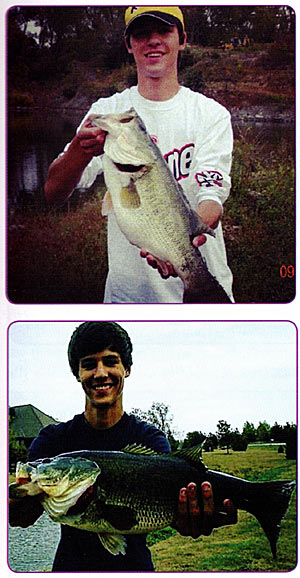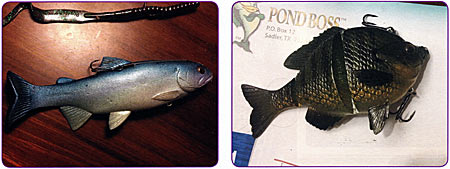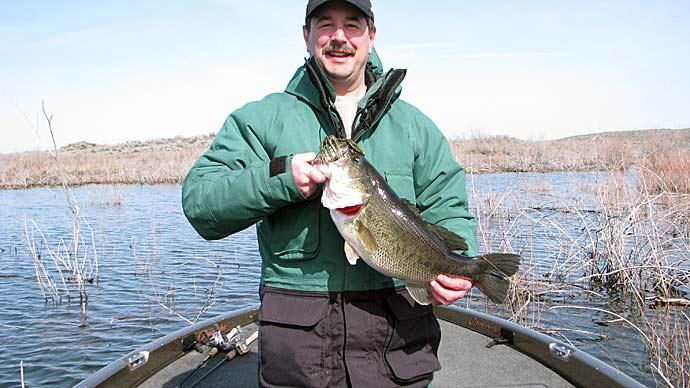
One of my defining fishing moments happened when I was about 15. It ended up being an epiphany that molded how I think and fish for giant fish.
I was reeling in a 10-inch bass I'd hooked and saw the biggest bass I had ever seen come out of the water and rip that bass clean off the hook. Then, with a giant splash and rip, I watched that little bass disappear into the mouth of that giant bass as she swam, satisfied, back to the depths. If you have ever had an experience like this, you may have also wondered, "What on earth can I do to catch the fish that is eating the fish I catch?" The image of that monster fish eating that little bass was burned into my mind, etched there to this day. So I told myself there has to be a way to target that ONE fish in this little pond.
Could it be possible to determine what fish you want to catch in your pond? As anglers, we cannot decide what fish in the pond bites our lure—or can we? When we use a crankbait or a spinnerbait, are we not solely targeting aggressive fish? Or are we not targeting finicky, less aggressive fish when we use a shaky head worm? Or, more importantly, when we use big lures, are we not targeting bigger fish? In this article, I'd like to dive into how we can start to selectively fish for the BIG fish we want to catch in our ponds using BIG lures.
Many anglers like to throw fun lures. To me, those are a spinnerbait, a lipless crankbait, or a chatterbait. These lures make a bunch of noise and flash, and they are very aggressive lures. Anglers often throw these lures to make a bass bite out of instinct. This is all fine and dandy, but think about the biggest bass in your pond. By this point, that fish has got to have your pond pretty much figured out, and her instincts are likely a little more honed than the smaller fish. Where those smaller fish may be turned on by the noise and vibration of a spinnerbait, all that flash and ruckus may turn a bigger fish away. Her instincts are more honed, and she will be more discerning and picky about what she targets.

Think about the average bass lure. Most bait companies sponsor professional tournament anglers, and those tournament anglers are looking for baits that produce a lot of bites per day. Even if an angler comes to the weigh-in with one twelve-pound bass, they will likely lose if someone else caught five three-pound bass! Therefore, these lure manufacturers are making lures designed to catch five fish in a day, not one big fish! The average bass lure is designed to catch average bass, simple as that. As pond owners, however, we rarely find ourselves in a tournament situation, and there is no set time to stop fishing. Therefore, if we so desire, we can spend as much time as we want, or need, to catch that twelve-pound bass—if it's there. However, as we now know, it isn't going to happen on the average bass lure!
One exciting thing about well-managed waters is the fact that there are so many fish in them. If the pond is managed well, which I'm sure yours is, there are so many aggressive fish in them. This means, in many cases, your cast could be cut short by a small fish biting your lure. Of course, the goal is to have a fish interrupt your retrieve, but what if your goal is to catch a monster bass, but two-pound bass keep interrupting your cast? Sometimes, these smaller fish can be a roadblock to catching the biggest bass of your life.
How many 1-2-pound bass have you caught in your life? The answer for me has got to be over 10,000. That's a ton of fish! But every single one of those fish was two pounds or under. Not exactly the target fish. Now, the question is, what if I had not caught those fish? What if they had not gotten in the way? No doubt my lure would have stayed in the water longer, and maybe, just maybe, it would have ended up in front of a giant bass. So, however crazy the concept may sound, to target and catch the big bass, we want to discourage those smaller fish from eating our lures. The best way to do that is to throw lures too big for them to target. I think it is about making a conscious decision to stop fishing for just fish in general, but to fish for the fish—the one fish that would make your day, month, or year.
There are four criteria I like to think about in terms of lure selection for big bass. I want a lure to be slow-moving, realistic, easy for the fish to catch, and most importantly, I want the lure to be BIG.
To me, a big lure can be any bass lure, as long as it is big. As I mentioned above, I don't use many reaction strike lures, but if you do, a big spinnerbait or crankbait fits the big lure criteria. However, my favorite big lures are big worms and big swimbaits. I think a giant worm is over 10 inches and, ideally, 12 inches long. A big swimbait is over 6 inches, ideally around seven or maybe even eight inches. I fully acknowledge that these sound like ridiculous sizes of lures. Sometimes, I wondered if I was going crazy chucking these dog-toy-sized lures into the water. I vividly recall the first time I threw a big 7-inch swimbait. Anyone fishing remotely close to me became immediately aware that I was fishing because my lure hitting the water sounded like a nine-pound bass smashing a frog. I had multiple people tell me I was crazy and that I was wasting my time.
Right around the time I felt a little self-conscious for using such a ridiculous-sized lure, I caught a ridiculous-sized fish. Of all my fond fishing memories, few will ever compare to the look on my buddies' faces when I reeled in an eight-pound bass on that ridiculous lure. So, all in all, you may look ridiculous throwing a 12-inch worm or an 8-inch swimbait. However, I assure you, if you stick to your guns and keep throwing those big lures, you will eventually be rewarded with a massive fish. And, just as importantly, you can reel in a big fish in front of your fishing buddies.

So, why do these big lures work? Why are big baits consistently catching big fish? Let's try our hardest to think like a bass to answer that question. When a bass sees your lure, what processes occur in that fish's mind to determine if she will eat that lure or pass on it? I think a bass, or any game fish, is doing a quick calculation in their mind. They are trying to figure out if the calories burned by moving to that lure and catching and killing it will be worth the calories consumed by eating that lure. If the answer to that question is ever no, or even possibly no, why would that fish travel to and eat your lure? The simple answer is she won't. If your lure is not worth it to the fish, the fish won't put any effort into eating your lure. So, while fishing, I constantly ask myself, "Is this lure I am using going to be worth it to the fish?"
So, to put this into angling terms, let's say that a 10-pound bass sees your 5-inch worm five feet away from her. Chances are pretty slim that fish will travel to eat that lure. She knows the calories she will burn to get to that lure, and chase it down, will not be made up by eating it. It is simply not that big. However, let's turn the tables—if that worm happens to be a 10-inch or even a 12-inch worm, it becomes a different deal to that fish. NOW, she knows the calories she burns to get that bait will easily be made up by all the calories she can consume by eating it. In short, it is worth it to her.
This concept can hold for any lure you may throw—a big swimbait, a giant worm, a big crankbait, creature bait, a Texas rig—you name it. When you increase the size of these baits, you increase your strike zone. When you use bigger bait, you make that lure worth it to so many more fish in your pond. That monster bass in your pond simply isn't going to put effort into chasing a lure unless it is truly worth it to her.
Of course, you can still catch giant bass on small lures. Many people have countered my big bait theory: "Well then, how come I caught my personal best on a tiny crappie jig?"
In my opinion, we can still catch colossal fish on small lures. The difference is that we have to hit the fish in the face with the lure. No double-digit bass will travel to eat a crappie jig. If all bass moved a long distance to eat a tiny meal, they would never get big. But, you can bet if you get that lure so close to that fish that the only calories she has to burn to eat it is to open her mouth and suck it in, you can surely catch her. My take, however, is why not throw a much bigger lure to increase your strike zone? While the strike zone with that crappie jig may be 6 inches, it could be 6 feet with that giant worm or swimbait.
Just like all fishing, nothing is guaranteed, but I believe if anglers increase the size of their lures and willingly adopt the mindset of fishing for the fish, instead of just any fish, they may find some fish in their pond they didn't even know existed. And if they are lucky, their friends may be there to watch them reel in their new personal best!
Reprinted with permission from Pond Boss Magazine




